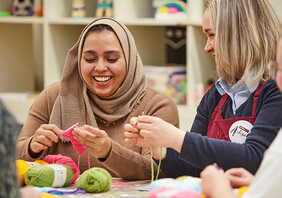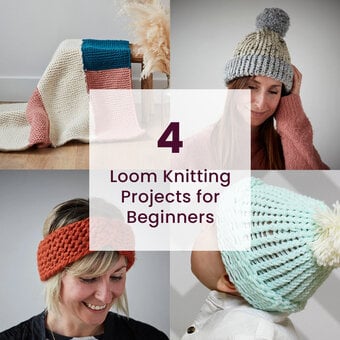The Ultimate Guide to Yarn
Choosing yarn is one of the most exciting parts of any knitting or crochet project. It’s not just about colour—though that’s certainly important—it’s about the feel, texture, and behaviour of the fibre.
Whether you’re creating a cosy jumper, a delicate lace shawl, or a simple scarf, the righ yarn can elevate your project from ordinary to exceptional.
Let’s dive into the world of yarn and discover what makes each type special.
You will need
The Ultimate Guide to Yarn
The first decision when choosing yarn is deciding between natural and synthetic fibres. Each has its benefits, and the choice largely depends on the project and personal preference.
Natural Fibres
Natural yarns are made from animal or plant fibres and are often prized for their softness, warmth, and breathability.
- Wool: A versatile staple, wool is warm, elastic, and perfect for everything from garments to accessories.
Merino wool is particularly soft, making it ideal for next-to-skin wear, while Shetland and Icelandic wools are more robust and great for outerwear.
Alpaca: Known for its luxurious softness and warmth, alpaca yarn is hypoallergenic and has a slight sheen. It’s perfect for cosy jumpers, hats, and scarves but can lack the elasticity of wool.
- Cotton: A plant-based fibre, cotton is breathable and durable. It’s perfect for summer garments, baby clothes, and home décor. However, it can be heavy and doesn’t stretch much, so keep that in mind for fitted projects.
- Silk: The ultimate in luxury, silk yarn has a beautiful sheen and drape. It’s perfect for elegant shawls and garments but can be slippery to work with and may require extra care.
- Linen: Made from the flax plant, linen yarn is lightweight and cool, making it ideal for summer garments. It softens with each wash but can be stiff when you first start working with it.
Synthetic Fibres
Synthetic yarns are made from man-made materials, often designed to mimic natural fibres while offering additional benefits.
- Acrylic: Affordable and widely available, acrylic yarn is easy to care for and comes in a huge range of colours. It’s great for beginners and projects that need to be machine washable, like blankets and children’s clothes.
- Nylon: Often blended with other fibres, nylon adds strength and elasticity. It’s commonly found in sock yarns and lightweight knits.
- Polyester: Durable and wrinkle-resistant, polyester yarn is often used in novelty or textured yarns. It’s easy to care for but can lack the softness of natural fibres.
Yarn weight refers to the thickness of the yarn and plays a crucial role in determining the look and feel of your finished project.
- Lace Weight: The thinnest yarn, perfect for delicate shawls and intricate lacework. It requires patience but produces stunning results.
- 4 Ply / Fingering Weight: A light yarn often used for socks, baby clothes, and fine garments. It offers good stitch definition and a lightweight feel.
-
Double Knitting (DK): A versatile mid-weight yarn, DK is ideal for a wide range of projects, from garments to accessories. It’s a great choice for beginners.
- Aran / Worsted Weight: Slightly thicker than DK, aran yarn is perfect for cosy jumpers, hats, and blankets. It knits up quickly and provides warmth without being too heavy.
- Chunky / Bulky: This thick yarn is great for quick projects and creates a bold, textured look. Ideal for winter wear and home décor.
- Super Chunky: The thickest yarn available, super chunky is perfect for oversized scarves, blankets, and statement pieces. It works up quickly but can be heavy.
Yarn comes in a variety of textures, which can dramatically affect the look of your finished piece:
Single Ply: A single strand of fibre, which creates a soft, slightly fuzzy texture. It’s great for airy knits but can pill more easily.
Multi-Ply: Multiple strands twisted together, offering durability and excellent stitch definition.
Bouclé: A looped yarn that creates a textured, nubby surface. It’s ideal for adding interest but can be tricky to work with.
Chenille: A velvety, plush yarn that’s incredibly soft. It’s perfect for blankets and cosy accessories but needs careful handling to avoid snags.
Ribbon and Tape: Flat, wide yarns that create a unique texture and drape. They’re often used in summer garments and accessories.
The colour of your yarn can transform your project, and there are several dyeing techniques to explore:
Solid Colours: A uniform colour throughout the yarn, ideal for showcasing complex stitch patterns.
Variegated Yarn: Yarn that shifts between multiple colours, creating a striped or mottled effect. It adds visual interest but can obscure intricate patterns.
Hand-Dyed Yarn: Each skein is unique, with subtle variations in colour. Hand-dyed yarns are prized for their individuality and artistry.
Gradient and Ombre: These yarns transition gradually from one colour to another, creating a beautiful, flowing effect.
Proper care ensures your handmade creations last for years:
Blocking: Blocking helps even out stitches and shape your finished piece. Use steam or wet blocking, depending on the fibre content.
Washing: Always check the yarn label for washing instructions. Natural fibres often require hand-washing, while synthetic blends are usually machine washable.
Storing Yarn: Store your yarn in a cool, dry place, away from direct sunlight. Plastic bins or zippered bags help protect against moths and dust.
The best yarn is one that suits both your project and your personal preferences. A delicate lace shawl calls for a fine, luxurious yarn, while a chunky blanket demands a soft, bulky yarn that works up quickly.
When in doubt, swatching is your best friend. Knitting or crocheting a small sample allows you to test the yarn’s texture, drape, and gauge, helping you avoid surprises later on.
Yarn is at the heart of every knitting and crochet project, and choosing the right one can make all the difference. Whether you prefer the warmth of wool, the softness of alpaca, or the practicality of acrylic, there’s a yarn out there to suit your needs.
Take the time to explore different fibres, weights, and textures. After all, part of the joy of crafting is discovering new materials and seeing how they transform into something beautiful. Happy stitching!












